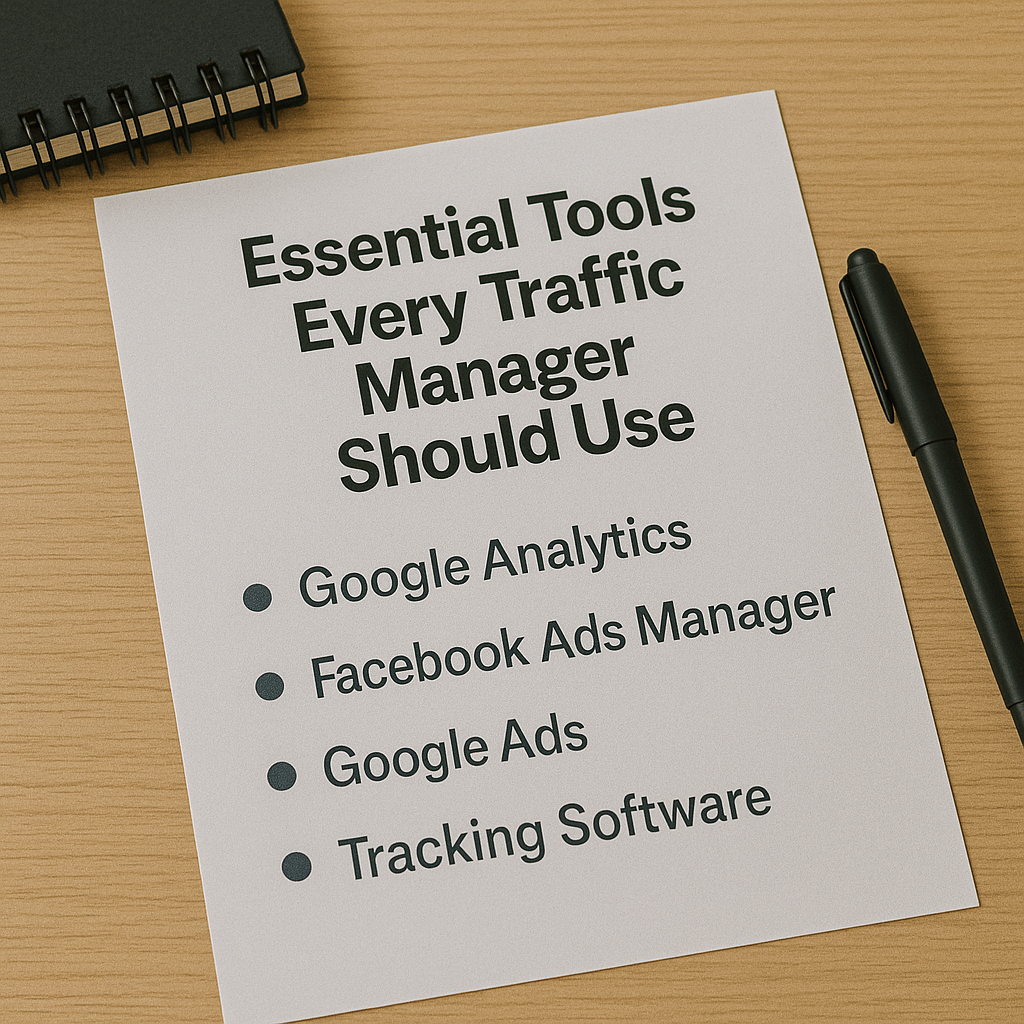Being a successful traffic manager isn’t just about knowing how to run ads—it’s about using the right tools to streamline your workflow, track results, and optimize performance. The digital ad space is fast-paced and detail-heavy, so having the right stack of platforms and apps makes all the difference.
In this article, you’ll learn about the essential tools every traffic manager should use, divided into categories like campaign setup, analytics, creative production, and productivity.
1. Campaign Management Platforms
These are the tools where you actually create, manage, and optimize your ads.
Meta Ads Manager (Facebook & Instagram)
This is where you set up and monitor your campaigns on Facebook and Instagram. You can:
- Create ad sets and audiences
- Track conversions and ROAS
- Test creatives and placements
- Analyze performance in real time
Tip: Use Business Manager to manage multiple ad accounts and assets if you handle multiple clients.
Google Ads
Used for search, display, YouTube, and shopping ads. Key features include:
- Keyword targeting and bidding
- Ad extensions for improved visibility
- Conversion tracking
- Smart campaigns with machine learning
Google Ads is essential for traffic managers targeting intent-based users.
TikTok Ads Manager (Optional)
If you’re working with younger audiences or viral content, TikTok Ads Manager is where you:
- Launch short-form video campaigns
- Use interest-based and lookalike audiences
- Track engagement metrics specific to TikTok behavior
2. Tracking and Analytics Tools
Without tracking, traffic management is just guesswork. These tools help you measure what’s working.
Google Analytics 4 (GA4)
Provides insight into user behavior after they click your ads:
- Bounce rate and session duration
- Conversion paths
- Funnel visualization
- Real-time traffic data
You can also connect GA4 to Google Ads and Tag Manager for advanced tracking.
Facebook Pixel
A must-have for retargeting and conversion tracking on Meta platforms. It allows you to:
- Track standard events (view content, add to cart, purchase)
- Build retargeting audiences
- Optimize campaigns for specific actions
Install it via the native plugin or Google Tag Manager for more control.
Google Tag Manager
This tool lets you install and manage tracking codes without touching the website code every time. You can:
- Add Facebook Pixel, Google Analytics, and custom scripts
- Set up event tracking (button clicks, form submissions)
- Troubleshoot tag firing in real time
Pro tip: Keep a checklist of tags per project or client to ensure nothing is missing.
UTM Generators (like utm.io)
UTMs allow you to track campaign performance across platforms and tools like GA4 or CRM. You can:
- See which ad or platform generated the conversion
- Split-test sources with clarity
- Analyze true ROI across channels
3. Creative and Copywriting Tools
Great creatives = better results. These tools help traffic managers create or collaborate on visuals and ad copy.
Canva (for quick graphics)
Easy-to-use drag-and-drop design tool to create:
- Ad creatives (square, story, banner formats)
- Lead magnets or PDFs
- Branded graphics for organic content
- Presentation materials for reports
Figma (for design collaboration)
Useful if you work with a designer. You can:
- View and edit shared creatives
- Organize creative tests visually
- Export ad images in correct formats
ChatGPT or Jasper (for ad copywriting)
Helps speed up brainstorming and writing for:
- Headlines and primary texts
- Product descriptions
- Landing page copy
- Email sequences
Pro tip: Always humanize AI-generated content before using it in live campaigns.
4. Landing Page and Funnel Builders
Sometimes, you need to manage or tweak landing pages. These platforms are user-friendly and optimized for conversions.
WordPress + Elementor
Perfect for building simple landing pages and blogs. Elementor makes it easy to:
- Customize layout without code
- Add countdown timers, forms, and testimonials
- Connect to email marketing tools
ClickFunnels or LeadPages
Popular among digital product creators. Offers ready-to-use funnel templates for:
- Webinars
- Lead magnets
- Sales pages
- Upsells and downsells
Instapage or Unbounce
Optimized for A/B testing and high-speed pages. Great for:
- Performance-driven campaigns
- Conversion rate optimization
- Multivariate testing
5. CRM and Lead Collection Tools
If your campaigns generate leads (instead of direct sales), use tools to store, qualify, and follow up with them.
Google Sheets (for basic lead tracking)
Great for quick setups with:
- Meta Lead Forms
- Zapier automation
- Manual exports from platforms
HubSpot CRM or Pipedrive
For advanced lead handling, segmentation, and automation. These tools allow you to:
- Track lead status (cold, warm, hot)
- Assign leads to sales reps
- Send automated follow-up sequences
Zapier or Make (for automations)
Connect ad platforms with Google Sheets, email tools, CRMs, and more—no coding needed.
Example:
New lead from Facebook → Auto-send welcome email → Log in Google Sheet
6. Reporting and Productivity Tools
Keeping clients or teams informed is essential. These tools help create visual reports and organize your work.
Google Looker Studio (formerly Data Studio)
Free tool that lets you build beautiful, real-time dashboards with:
- Custom graphs and tables
- Multiple data sources (Meta, Google, CRM)
- Branded layouts for clients
Loom
Record quick screen share videos to:
- Explain reports
- Show campaign structures
- Deliver audits to clients
Clients love video reports—they’re faster to understand than emails.
Trello or Notion
Use these tools to:
- Organize campaign calendars
- Create checklists for campaign launch
- Share project updates with clients or teams
Final Thoughts: Use Tools to Save Time, Not Just Look Smart
You don’t need to use all these tools at once. Start with the essentials:
- Meta Ads Manager or Google Ads
- Google Analytics + Facebook Pixel
- Canva for creatives
- Google Sheets + Looker Studio for reporting
As your campaigns and client base grow, you can add more advanced tools.
The most successful traffic managers don’t do everything manually. They use tools strategically to optimize performance, save time, and scale results.

